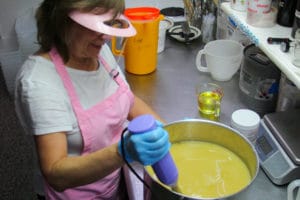
We need lye to make handcrafted soap. But there is no lye left in the soap. To understand why there is no lye in soap, you need to understand the difference between a physical change, and a chemical change.
Physical Change verses Chemical Change
A physical change affects the form of something, not the chemical composition. Ice melting, dissolving Kool-Aid into water, breaking a juice glass are all physical changes. Water is still H2O, if it’s a solid (ice cube), liquid (water) or a gas (steam). Once the water evaporates from your Kool-Aid, you’re left with the same dried Kool-Aid you started with. You may not be able to put the broken juice glass back together, but the broken pieces are still glass. The chemical composition is the same.
A chemical change happens when a substance combines with another to form a new substance. Think about iron and rust. If you leave iron exposed outside (in the presence of moisture and oxygen in the atmosphere), the iron will rust. Rust is a new substance, and it will never go back to being iron, water and oxygen.
Here’s another one. If you take a match to a piece of paper, it will burn into a pile of ash. you can never turn that ash back into paper and a match. It’s been chemically changes.
It’s the same with soap. We take lye and water and mix it with oil. A chemical reaction takes place in the soap pot, and the lye and oils change into soap and glycerin. If you measure everything correctly, there is no lye left in the soap. In fact, unless you’re making laundry soap, soap makers add extra oil to the soap pot so our soaps have a “super-fat”, or extra oil in the bar.
So there is no lye left in soap if it’s been properly made. It’s safe for you to use and enjoy.
Yours in Gratitude,
Angela

Leave a Reply